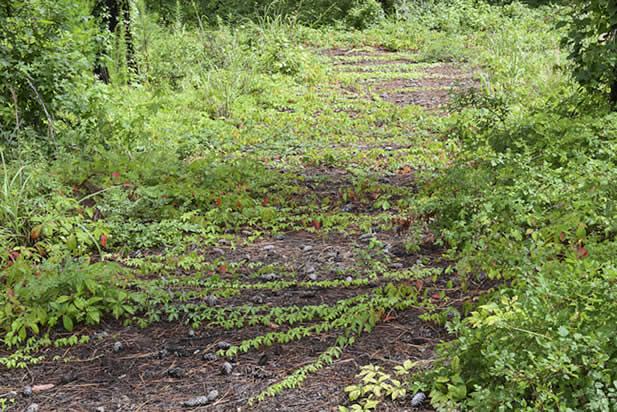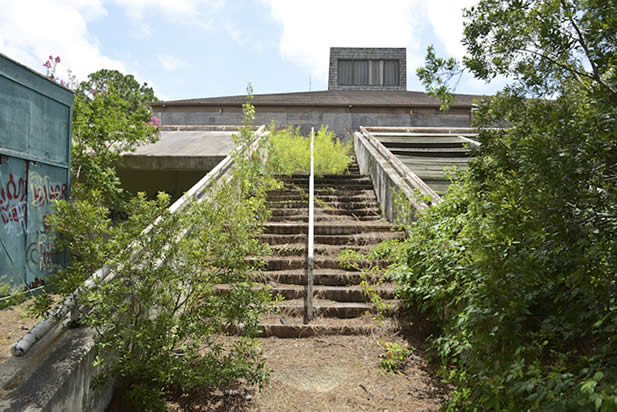Most of the town’s 28,000 citizens are transplanted Northerners, lured there by golf. From the late 1980s to the early 2000s, five new courses opened every year in Myrtle Beach, until it boasted 120 courses – one for every 200 residents.
Fairway to Heaven
Exploring the abandoned golf courses of Myrtle Beach, South Carolina

Before we walked on the abandoned golf course, the
realtor charged with selling the condos around it told us that our plan
was “suicidal.” We would run into copperhead snakes, he said, if not the
bikers and meth cookers recently discovered on the property. The
warning didn’t entirely displease us, for we didn’t intend to play golf.
Photographer Robert Dawson and I had come to Myrtle Beach, South
Carolina, one of the country’s top golfing destinations, to walk its
derelict golf courses, to see what kinds of life persisted on a course
after it died, to find out whether nature reclaimed it. In this contest,
we were on nature’s side.
Nature had been on a long losing streak in Myrtle Beach. Although
only 28,000 people live there, it looks like the capital of cheesy
enterprise, as if strip clubs and cigarette outlets and fireworks stores
from across the country had been shaken from their foundations and set
down in Myrtle Beach, where they could all be together. Strip malls line
the town’s highways like paramecium. They include beachwear shops where
three t-shirts sell for ten dollars; a store called “Vices” that sells
cigarettes and liquor; jaw-droppingly grandiose miniature golf courses
like “Molten Mountain,” which features a smoking, three-story-high hump,
around which the course meanders; plus golf clothes stores, golf supply
stores, and a golf shoe store. Virtually all the food is fast. Driving
through Myrtle Beach felt like looking from a three-dimensional universe
into Plato’s two-dimensional cave. We spent three July days exploring
the town, and despite the swarming bugs and the blanket of humidity, we
felt relief each time we turned off the highway and onto an abandoned
course.
Most of the town’s 28,000 citizens are transplanted Northerners, lured there by golf. From the late 1980s to the early 2000s, five new courses opened every year in Myrtle Beach, until it boasted 120 courses – one for every 200 residents. Back then, golf’s popularity was soaring, and the demand for more courses seemed boundless. First the town fed on the sport’s allure, then the housing boom fed on the golf boom. Developers put homes and condos alongside every fairway of every new course, using the locations to boost the homes’ sales prices. The housing mania had so much momentum that when golf’s popularity waned in the second half of the decade, developers simply dropped golf from their equation. They leveled the courses and turned them into more housing tracts. That worked until the housing bubble also burst and real estate prices plummeted. Most of the 22 courses that closed in Myrtle Beach turned into residential developments, but half a dozen weren’t converted in time. Instead, they were abandoned. Those were the courses that interested us.
The natural reclamation of a golf course is not a simple thing. A
golf course, after all, may inhabit 150 acres of verdant terrain, but
it’s a tamed and highly stylized simulacrum of nature, not nature
itself. Golfers seem to think of such landscapes as nature perfected,
designed for entertainment and absent messy cycles and seasons,
certainly nothing red in tooth and claw. Elaborate sprinkler systems
serve up copious amounts of water. Insecticides, herbicides, and
fertilizers are applied liberally to make greens and fairways pleasingly
iridescent. Trees are carefully positioned in long rows, and lakes are
treated with dyes to make them look like tropical atolls; one dye is
actually called “Blue Lagoon.” Some televised golf tournaments even dub
in fake bird sounds.
The course pulsed with a jungle-like intensity, as if it were making an exuberant transition to nature reserve.
It’s no doubt a good thing that the abandoned courses no longer
receive their chemical allotments, but the land won’t return to its
pre-European composition. The longleaf pine forests that once dominated
the region were cut down centuries ago, and the state’s coastal
hydrology has been drastically altered by the installation of more than
14,000 manmade ponds, including hundreds on golf courses. So it’s an
open question: Without groundskeepers’ manicured tending, will native
species stage comebacks on the courses, or will their degradation
attract the sorts of invasive species that thrive in disturbed
landscapes? Or, perhaps more to the point: Will the courses’ newfound
wildness serve beauty or ugliness?
It was at the first course we visited, Bay Tree, that the realtor
issued his sinister warning. He explained that Bay Tree’s descent had
been steep. When it opened in 1972, it flaunted its 54 holes, making it
the first three-course layout in the country. Unfortunately, from a
golfing perspective, the one glaring weakness of Myrtle Beach courses is
that they’re relentlessly, tediously flat, and Bay Tree was no
exception. In three-and-a-half decades of operation, its two biggest
claims to prominence were that it once hosted the final stage of a
qualifying tournament for one of the US golf tour’s four “grand slam”
events, and that Dan Quayle once played there. I can’t imagine faint
praise more damning than that. When the course closed in 2006, homeless
people took up residence in its clubhouse, so the clubhouse was torn
down a year later.
I spent much of our stroll through Bay Tree trying to decide whether
the realtor really meant his warning. True enough, the place was
enormously overgrown, forbidding, with a haunted feeling. Its ponds were
brown and murky and rimmed with six-foot-high foliage. The hole markers
had long since disappeared, but we could still make out fairways by the
trees that lined them and tees and greens by the mounds they usually
topped. Now that the greens’ once carefully nurtured Bermuda grass had
died off, their sand foundation, installed to promote drainage, was
exposed: Seeing these brown-gray expanses felt like looking at
skeletons. Instead of snakes, or the feral pigs that were chased off the
property two years ago, we ran into bunnies, which froze in their
tracks as if they thought that made them invisible. Next to the third
hole, we found a crumbling bathroom, bathed in spray-painted slogans
like “THUG SPOT.” Thugs indeed: Only two weeks earlier police made
arrests after finding a meth lab deep in the course’s interior. Bay Tree
had become a dystopia.
Two days later, we found its antithesis, Deer Track, as tame as Bay
Tree was wild, where someone, presumably the owner, had cut back the
vegetation nearly to its pre-abandonment height. The place still looked
like a golf course, only more serene, as it lacked golfers.
We were driving through Calabash, North Carolina (considered a part
of the Myrtle Beach region despite being across the state line) when we
found Marsh Harbour, our Goldilocks golf course – neither too wild nor
too tame. We would have missed the course if not for catching sight of a
sign announcing it. The sign turned out to be the only well-maintained
structure on the premises. We walked past a smaller sign that said
“Private Property” and a little farther in, a sign warning of a dog. But
we saw no dogs, nor any other four-legged animals. They were there,
though, somewhere – we occasionally heard howls. The course pulsed with a
jungle-like intensity, as if it had found its true calling, as if it
were managing an exuberant transition to nature reserve.
We felt like archeologists. We found red, white, and blue course
markers and a faded-green golf ball washer. Outside a shed, we came
across a decomposing green-and-yellow John Deere Accumaster 1800, a
golf-cart-sized vehicle that once spewed herbicides and pesticides. Its
spray pipes, now retracted, looked like insect antennae. Three tires
were flat, and the cap on the chemical tank was missing. The sprayer had
lost its menace. Now it just seemed like a relic.
Next to the first hole fairway, we spotted a wooden fence with a few
slats missing, and realized it didn’t quite enclose a house once
intended to look out on the golf course. The housing meltdown must have
hit just as it was being built, for it wasn’t completed. A
not-yet-installed microwave sat on a kitchen counter. The interior walls
still lacked insulation; outside, we found piles of the pink stuff,
rotting and merging into the cement deck. A few yards away, we peered
into a kidney-shaped swimming pool, half-filled with a lustrous muck as
thick as porridge. It felt like we were looking at a collapsed
civilization.
A short stroll from the house, we found the Marsh Harbour clubhouse.
Even though it was boarded up, it looked soft and luscious, achieving a
beauty and dignity it could not possibly have boasted while open. On
three of its four sides, broad white staircases led up to it. Lush,
leafy foliage, green flecked with red, had inveigled its way though
cracks in the steps and had wound around the railings, which were
adorned with remnants of yellow “CAUTION” tape that looked like
sun-flecked petals. In color and composition, the staircase formed a
perfectly balanced tableau, as if this were the manifestation it was
intended for. The crumbling clubhouse looked honest, even elegant, while
underlining the ephemerality of the golf course it had served. The
steps pointed upwards, and the vines climbed up the steps. They
suggested a resurrection.
Jacques Leslie’s latest work of narrative nonfiction is an e-book called A Deluge of Consequences, which portrays a project in Bhutan to counter the effects of climate change.
Robert Dawson teaches photography at San Jose State and Stanford University. His latest book The Public Library: A Photographic Essay by Robert Dawson will be published in April by Princeton Architectural Press.
Driving through Myrtle Beach felt like looking from a three-dimensional universe into Plato’s two-dimensional cave.








No comments:
Post a Comment